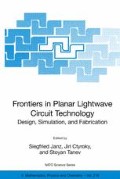Abstract
Investigation of spatiotemporal dynamics of optical pulse in step-index planar waveguide with Kerr nonlinearity is presented which is based on numerical solution of a (2D+T) wave equation for slowly varying amplitude of the total field. Effect of emission of radiation field that is specific for open dielectric waveguides is taken into account. This emission can be observed, first, as a result of light beam propagation through waveguide junctions, and second, due to some effects that vary the temporal distribution of an ultra-short optical pulse propagating in a regular nonlinear waveguide. Two types of junctions in weakly-guiding planar waveguides are under consideration: both waveguides have the same width and refractive index profile but possess different nonlinear properties, and both waveguides have the same refractive index profile and nonlinearity but their widths are different. In the quasi-static approximation, the problem of optical pulse propagation through the junctions is reduced to the solution of a 2D equation for the pulse envelope with time coordinate given as a parameter. Spatial transformations of the stationary components of the pulse behind the junctions are studied in detail depending on their power and waveguide width. The approach is based on general methods of the theory of Hamiltonian dynamical systems and consists of the following steps: (i) finding the set of stationary nonlinear modes, (ii) investigation of power-dispersion diagrams, and (iii) investigation of global dynamics. Transmittance versus power dependencies demonstrate the applicability of the junctions for pulse shaping and power controlling. In the case of ultrashort optical pulses, self-steepening effect and second-order group velocity dispersion effect are shown to prevent formation of stable spatiotemporal pulse distribution owing to the emission of radiation field outside the guiding region.
Access this chapter
Tax calculation will be finalised at checkout
Purchases are for personal use only
Preview
Unable to display preview. Download preview PDF.
REFERENCES
S.A. Akhmanov, V.A. Vysloukh, A.S. Chirkin, Optics of Femtosecond Laser Pulses (American Institute of Physics, NY 1992).
G.P. Agrawal, Nonlinear fiber optics (Academic Press, Inc., Boston, MA, 1989).
A.A. Zozulya, S.A. Diddams, A.G. Van Engen, T.S. Clement, “Propagation dynamics of intense femtosecond pulses: multiple splitting, coalescence and continuum generation”, Phys.Rev.Lett. 82, 1430-1433 (1999).
K. Mori, H. Takara, and S. Kawanishi, “Analysis and design of supercontinuum pulse generation in a single-mode optical fiber”, J.Opt.Soc.Am. 18, 1780-1792 (2001).
G. Fibich, W. Ren, X-P. Wang, “Numerical simulations of self-focusing of ultrafast laser pulses”, Phys. Rev. E 67, 056603 (2003).
E.A.Romanova, L.A.Melnikov, “Optical pulse propagation in an irregular waveguide with spatially distributed Kerr-like non-linearity”, Optics and Spectroscopy 95, 268-275 (2003).
E.A. Romanova, L.A. Melnikov, “Spatiotemporal dynamics of femtosecond pulses in non-linear optical waveguides with material dispersion”, Optics and Spectroscopy 96, 90-95 (2004).
N.N. Akhmediev, “Spatial solitons in Kerr and Kerr-like media”, Opt. and Quantum Electron. 30, 535-569 (1998).
W.P. Huang (Ed.), Methods for modelling and simulation of guided-wave optoelectronic devices: waves and interactions (PIERS 11, EMW Publishing, Cambridge, MA, 1995).
P.G. Suchoski, Jr., and V. Ramaswamy, “Exact numerical technique for the analysis of step discontinuities and tapers in optical dielectric waveguides”, J.Opt.Soc.Am. A. 3, 194-203 (1986).
J.M. Ortega, W.G. Poole, Jr.: An introduction to numerical methods for differential equations (Pitman Publishing Inc., 1981).
J. Yamauchi, J. Shibayama, and H. Nakano, “Application of the generalized Douglas scheme to optical waveguide analysis”, Opt. Quantum Electron. 31, 675-687 (1999).
Y.P. Chiou, Y.C. Chiang, H.C. Chang, “Improved three-point formulas considering the interface conditions in the finite-difference analysis of step-index optical devices”, J. Lightwave Technol. 18, 243-251 (2000).
A.W. Snyder and J.D. Love, Optical Waveguide Theory (Chapman & Hall, London, England, 1983).
H.W. Schurmann, V.S. Serov and Yu.V. Shestopalov, “TE-polarized waves guided by a lossless nonlinear three-layer structure”, Phys.Rev.E 58, 1040 - 1050 (1998).
C.W. McCurdy and C.K. Stroud, “Eliminating wavepacket reflection from grid boundaries using complex coordinate contours”, Computer Phys. Commun. 63, 323-330 (1991).
G.R. Hadley, “Transparent boundary conditions for the BPM”, IEEE J. Quantum Electron. 28, 363-370 (1992).
L.A. Melnikov, E.A. Romanova, E.V. Bekker, “Non-linear transmission of a single-mode optical fiber with a sharp change of core diameter”, Optics and Spectroscopy 89, 761-765 (2000).
E.V. Bekker, E.A. Romanova, L.A. Melnikov, T.M. Benson, P. Sewell, “All-optical power limiting in waveguides with periodically distributed Kerr-like nonlinearity”, Appl. Phys. B 73, 531-534 (2001).
Author information
Authors and Affiliations
Editor information
Editors and Affiliations
Rights and permissions
Copyright information
© 2006 Springer
About this paper
Cite this paper
Romanova, E., Melnikov, L., Bodrov, S., Sergeev, A. (2006). PROPAGATION OF OPTICAL PULSES THROUGH NON LINEAR PLANAR WAVEGUIDES WITH JUNCTIONS. In: Janz, S., Ctyroky, J., Tanev, S. (eds) Frontiers in Planar Lightwave Circuit Technology. NATO Science Series II: Mathematics, Physics and Chemistry, vol 216. Springer, Dordrecht. https://doi.org/10.1007/1-4020-4167-5_07
Download citation
DOI: https://doi.org/10.1007/1-4020-4167-5_07
Publisher Name: Springer, Dordrecht
Print ISBN: 978-1-4020-4164-8
Online ISBN: 978-1-4020-4167-9
eBook Packages: Physics and AstronomyPhysics and Astronomy (R0)

